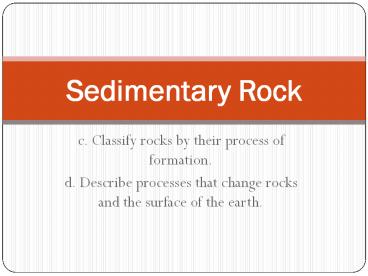c. Classify rocks by their process of formation. - PowerPoint PPT Presentation
1 / 21
Title:
c. Classify rocks by their process of formation.
Description:
Sedimentary Rock c. Classify rocks by their process of formation. d. Describe processes that change rocks and the surface of the earth. Sedimentary Rock Formed from ... – PowerPoint PPT presentation
Number of Views:103
Avg rating:3.0/5.0
Title: c. Classify rocks by their process of formation.
1
Sedimentary Rock
- c. Classify rocks by their process of formation.
- d. Describe processes that change rocks and the
surface of the earth.
2
Sedimentary Rock
- Formed from particles of sediment deposited by
wind and water. - Sediment is small pieces of solid materials that
come from rocks or living things.
3
Stratification
- Yes, all these rocks are layered or stratified.
4
Weathering
- The process by which exposed rock is broken down
into small pieces by the elements of nature
(wind, rain, ice, chemical actions, plants, etc.)
5
Origins of Sedimentary Rock
- Wind, water, ice, sunlight, and gravity all cause
rock to physically weather into fragments. - Through erosion, these rock and mineral
fragments, called sediment, are moved from one
place to another. - The sediment is deposited in layers, and
eventually newer layers cover the older layers.
6
Erosion
- Occurs when water or wind loosens rock and soil
and carries it away.
7
Deposition
- The process by which the sediment settles out of
the water or air carrying it. - Sediment is deposited when the wind or water
slows down.
8
Compaction
- As the sediments settle they will loosely fit on
top of each other. - As the years go by, more and more sediment is
added. - The bottom layers get compacted by the weight of
the layers above them.
9
Cementation
- While compaction is going on, minerals in the
rock slowly dissolve. - The dissolved minerals seep into the spaces
between the compacted sediment. - They crystallize and glue the sediments together.
10
Lithification
- The process by which sediment becomes sedimentary
rock. - From Green word lithos, which means rock.
- Erosion
- Deposition
- Compaction
11
Types of Sedimentary Rock
- Clastic formed when rock fragments are squeezed
together. - Organic (biological) formed from the remains of
living things. - Chemical formed when dissolved minerals
crystallize.
12
Conglomerate and Breccia
- Formed from a mixture of rock fragments of
different sizes. - Conglomerate has rounded edges.
- Breccia has larger fragments with sharp edges
13
Sandstone
- Formed from sand on beaches, ocean floors, river
beds, and deserts. - Mainly quartz.
14
Shale
- Clastic rock from from tiny particles of clay.
- Water deposits tiny clay particles in thin
layers. - Feels smooth and splits easily into flat sheets.
15
Organic Sedimentary Rock
- Formed from the remains of plants and animals
that were deposited in thick layers. - Also called biological rock.
16
Coal
- Formed from the remains of ancient swamps.
- As layer upon layer of dead plants built up, the
bottom layers were compacted into coal. - Stored chemical energy from
17
Limestone
- Formed from the shells of ancient sea animals and
plants. - Shells fall to the bottom of the ocean in layers,
some 100s of meters thick. - Compaction creates limestone.
18
Chalk
- Formed from the shells of ancient sea life.
- Creates layers 100s of feet thick.
- White Cliffs of Dover
19
Chemical Sedimentary Rock
- Formed when water with dissolved minerals
evaporates. - The left behind minerals will crystallize.
20
Halite
- Rock Salt
- Formed from seas and oceans that dried up.
- The salt forms large crystals.
21
Gypsum
- Made from calcium deposits.
- Used to make sheet rock for homes.































